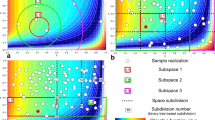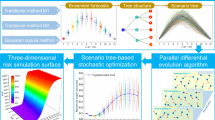Abstract
Ensemble-based optimization has recently received great attention as a potentially powerful technique for life-cycle production optimization, which is a crucial element of reservoir management. Recent publications have increased both the number of applications and the theoretical understanding of the algorithm. However, there is still ample room for further development since most of the theory is based on strong assumptions. Here, the mathematics (or statistics) of Ensemble Optimization is studied, and it is shown that the algorithm is a special case of an already well-defined natural evolution strategy known as Gaussian Mutation. A natural description of uncertainty in reservoir management arises from the use of an ensemble of history-matched geological realizations. A logical step is therefore to incorporate this uncertainty description in robust life-cycle production optimization through the expected objective function value. The expected value is approximated with the mean over all geological realizations. It is shown that the frequently advocated strategy of applying a different control sample to each reservoir realization delivers an unbiased estimate of the gradient of the expected objective function. However, this procedure is more variance prone than the deterministic strategy of applying the entire ensemble of perturbed control samples to each reservoir model realization. In order to reduce the variance of the gradient estimate, an importance sampling algorithm is proposed and tested on a toy problem with increasing dimensionality.





Similar content being viewed by others
References
Akimoto Y, Nagata Y, Ono I, Kobayashi S (2010) Biderectional relation between CMS evolution strategies and natural evolution strategies. PPSN XI Part I LNCS 6238:154–163
Amari SI (1998) Natural gradients works efficiently in learning. Neural Comput 10(2):333–339
Bouzarkouna Z, Ding D, Auger A (2011) Well placement optimization with the covariance matrix adaptation evolution strategy and meta-models. Comput Geosci:1–18
Brouwer DR, Naevdal G, Jansen JD, Vefring EH, van Kruijsdijk CPJW (2004) Improved reservoir management through optimal control and continuous model updating. In: SPE Annual Technical Conference and Exhibition, Houston. Texas, pp 26–29 (SPE90149)
Chen Y (2008) Efficient ensemble based reservoir management. Ph.d. thesis, University of Oklahoma
Chen Y, Oliver DS (2012) Localization of ensemble-based control-setting updates for production optimization. SPE J 17(1):122–136
Chen Y, Oliver DS, Zhang D (2009) Efficient ensemble-based closed-loop production optimization. SPE J 14(4):634–645
Ding YD (2008) Optimization of well placement using evolutionary algorithms. In: Europec/EAGE Conference and Exhibition
Do ST, Reynolds AC (2013) Theoretical connections between optimization algorithms based on an approximate gradient. Comput Geosci 17(6):959–973
Fonseca RM, Leeuwenburgh O, Hof PVD, Jansen JD (2013) Improving the ensemble optimization method through covariance matrix adaptation (cma-enopt). In: SPE Reservoir Simulation Symposium
Hansen N, Ostermeier A (1996) Adapting arbitrary normal mutation distributions in evolution strategies: The covariance matrix adaptation. In: 1996 IEEE International Conference on Evolutionary Computation. IEEE, pp 312–317
Hansen N, Ostermeier A (2001) Completely derandomized self-adaptation in evolution strategies. Evol Comput 9(2):159–195
Hasan A, Foss B, Sagatun S (2013) Optimization of oil production under gas coning conditions. J Pet Sci Eng 105:26–33
Jansen J (2011) Adjoint-based optimization of multi-phase flow through porous media—a review. Comput Fluids 46:40–51
Jansen JD, Brouwer DR, Naevdal G, van Kruijsdijk CPJW (2004) Closed-loop reservoir management. In: EAGE 66th Conference & Exhibition. Paris, pp. 7–10 (Presented at Workshop “Uncertainties in production forecasts and history matching”)
Leeuwenburgh O, Egberts PJ, Abbink OA (2010) Ensemble methods for reservoir life-cycle optimization and well placement. SPE/DGS Saudi Arabia Sect Tech Symp Exhib 4–7:2010
Lorentzen RJ, Berg AM, Nævdal G, Vefring EH (2006) A new approach for dynamic optimization of water flooding problems. In: SPE Intelligent Energy Conference and Exhibition. Amsterdam, pp 11–13 (SPE99690)
Lozano J, Larranaga P, Inza I, Bengoetxea E (2006) (eds) The CMA Evolution Strategy: a comparing review. Springer, pp 75–102
Nwaozo J (2006) Dynamic optimization of a water flood reservoir. Ph.D. thesis, University of Oklahoma
Peters E et al (2011) Brugge paper SPE REE
Pajonk O, Schulze-Riegert R, Krosche M, Hassan M, Nwakile MM (2011) Ensemble-based water flooding optimization applied to mature fields. SPE Middle East Oil Gas Show Conf 25–28:2011
Raniolo S, Dovera L, Cominelli A, Callegaro C, Masserano F (2013) History match and polymer injection optimization in a mature field using the ensemble kalman filter. In: 17th European Symposium on Improved Oil Recovery, St. Petersburg, Russia. pp 16–18
Rosenbrock H (1960) An automatic method for finding the greatest or least value of a function. Comput J 3(3):175–184
Sarma P, Durlofsky LJ, Aziz K, Chen WH (2006) Efficient real-time reservoir management using adjoint-based optimal control and model based updating. Comput Geosci 10:3–36
Schulze-Riegert R, Bagheri M, Krosche M, Kueck N, Ma D (2011) Multiple-objective optimization applied to well path design under geological uncertainty. SPE Reserv Simul Symp 21–23:2011
Su H-J, Oliver DS (2010) Smart well production optimization using an ensemble-based method. SPE Reserv Eval Eng 13(6):884–892
Sun Y, Wierstra D, Schaul T, Schmidhuber J (2009) Efficient natural evolution strategies. In: Proceedings of GECCO. pp 539–545
Tarantola A (2005) Inverse problem theory: methods for data fit-ting and model parameter estimation
van Essen GM, Zandvliet MJ, van den Hof PMJ, Bosgra OH, Jansen JD (2006) Robust waterflooding optimization of multiple geological scenarios. In: SPE Annual Technical Conference and Exhibition, San Antonio. Society of Petroleum Engineers, Texas (SPE102913)
Acknowledgments
The first author acknowledges the Research Council of Norway and the industrial participants, ConocoPhillips Skandinavia AS, BP Norge AS, Det Norske Oljeselskap AS, Eni Norge AS, Maersk Oil Norway AS, DONG Energy AS, Denmark, Statoil Petroleum AS, GDF SUEZ E&P NORGE AS, Lundin Norway AS, Halliburton AS, Schlumberger Norge AS, Wintershall Norge AS, of The National IOR Centre of Norway for financial support.
Author information
Authors and Affiliations
Corresponding author
Rights and permissions
About this article
Cite this article
Stordal, A.S., Szklarz, S.P. & Leeuwenburgh, O. A Theoretical look at Ensemble-Based Optimization in Reservoir Management. Math Geosci 48, 399–417 (2016). https://doi.org/10.1007/s11004-015-9598-6
Received:
Accepted:
Published:
Issue Date:
DOI: https://doi.org/10.1007/s11004-015-9598-6




